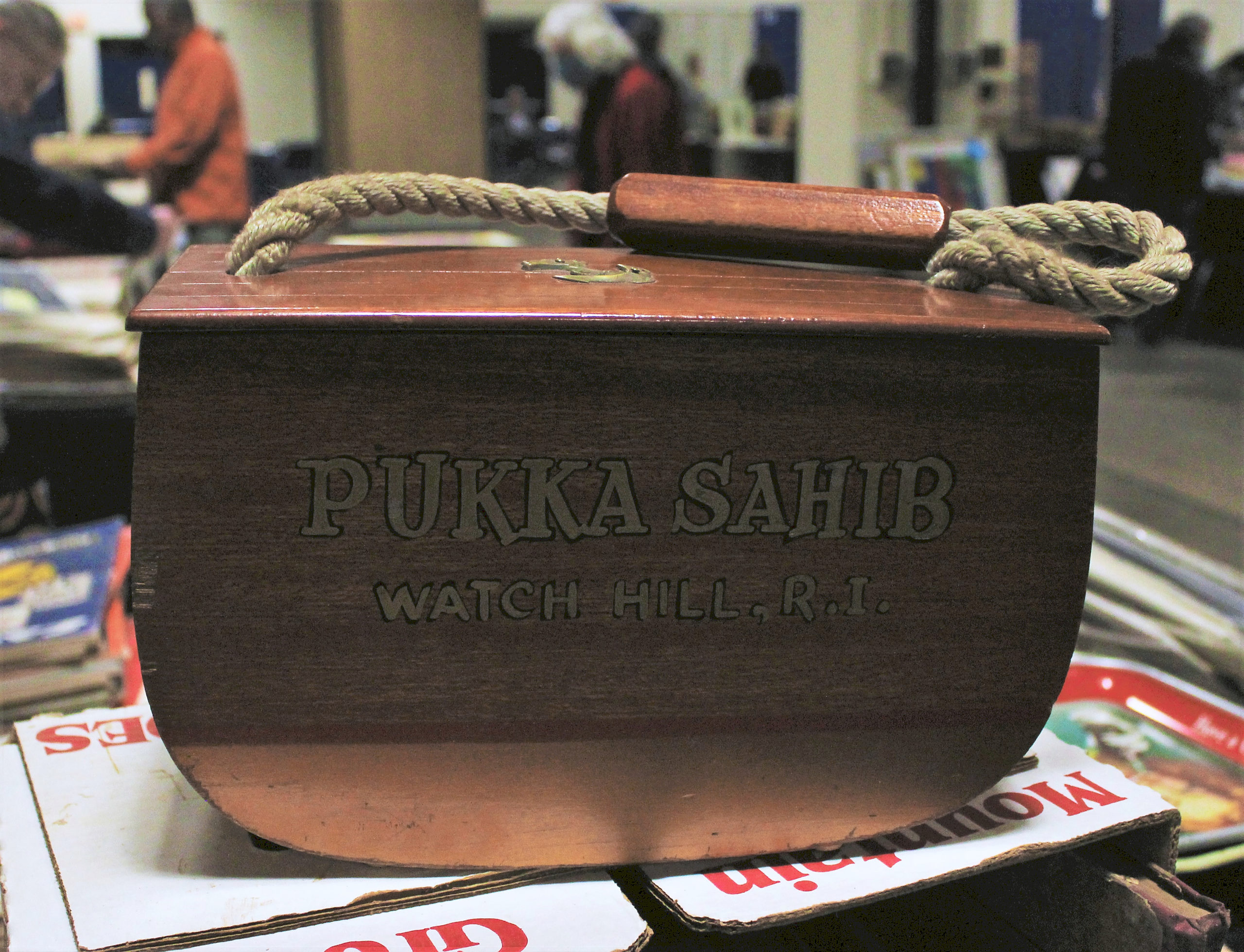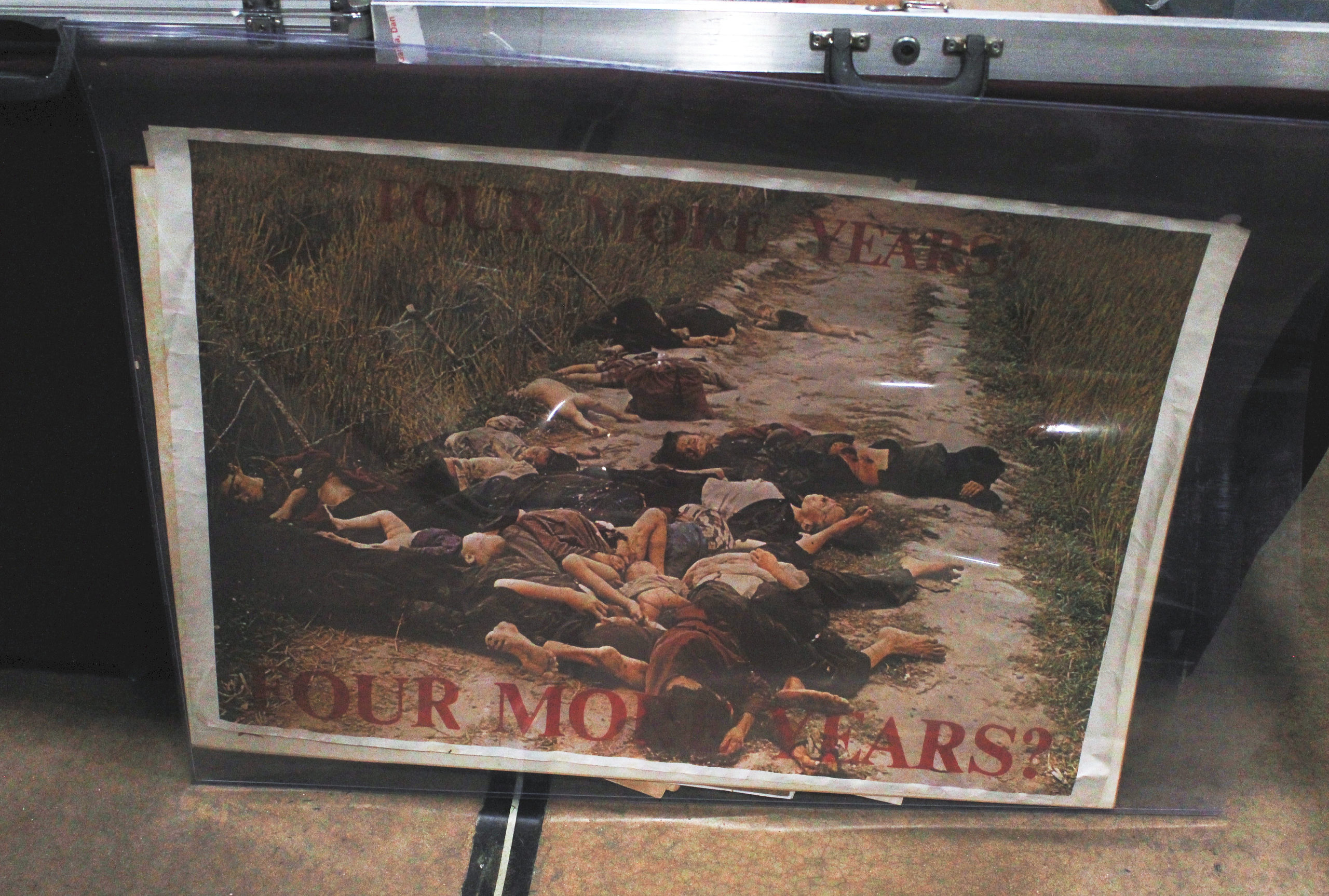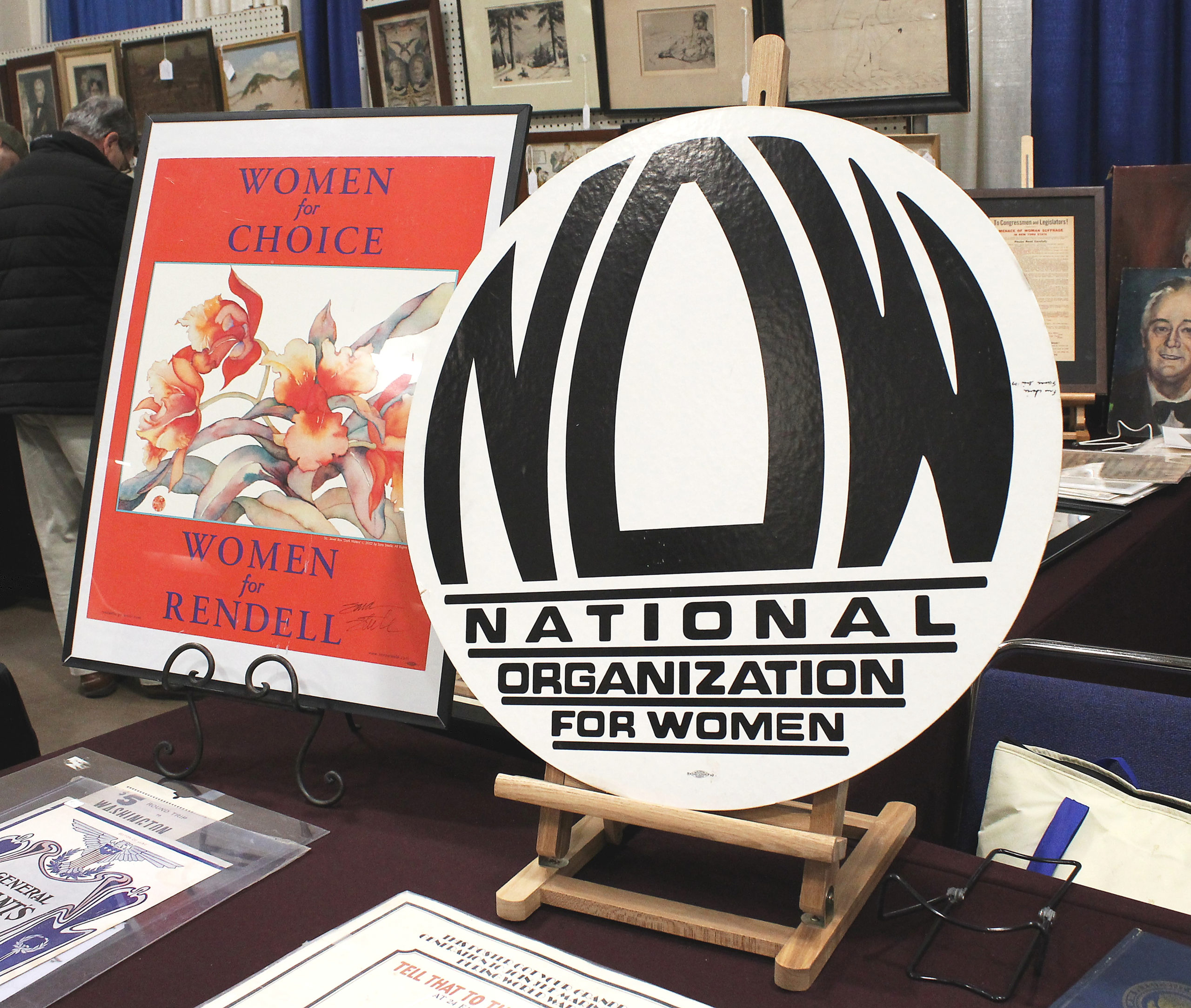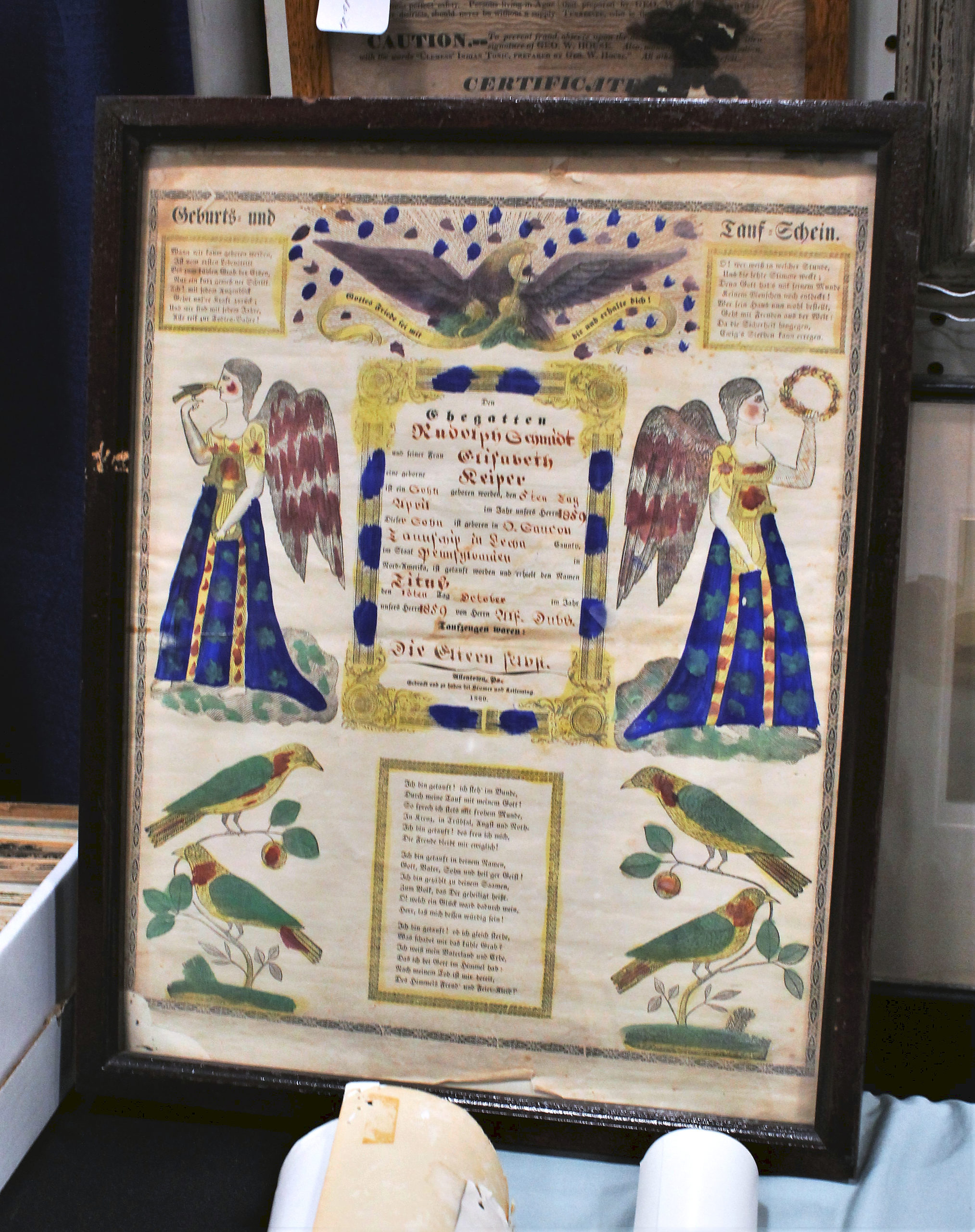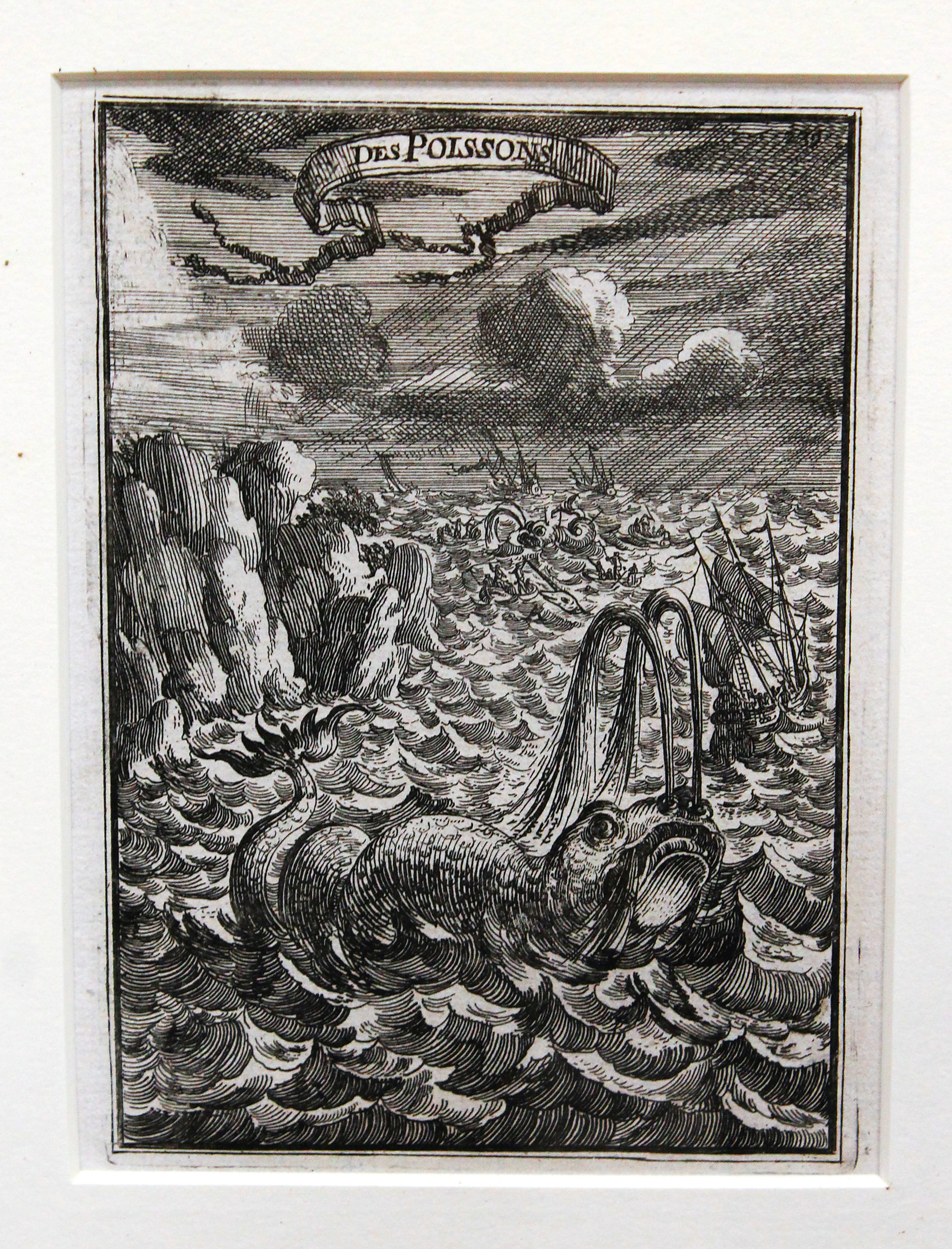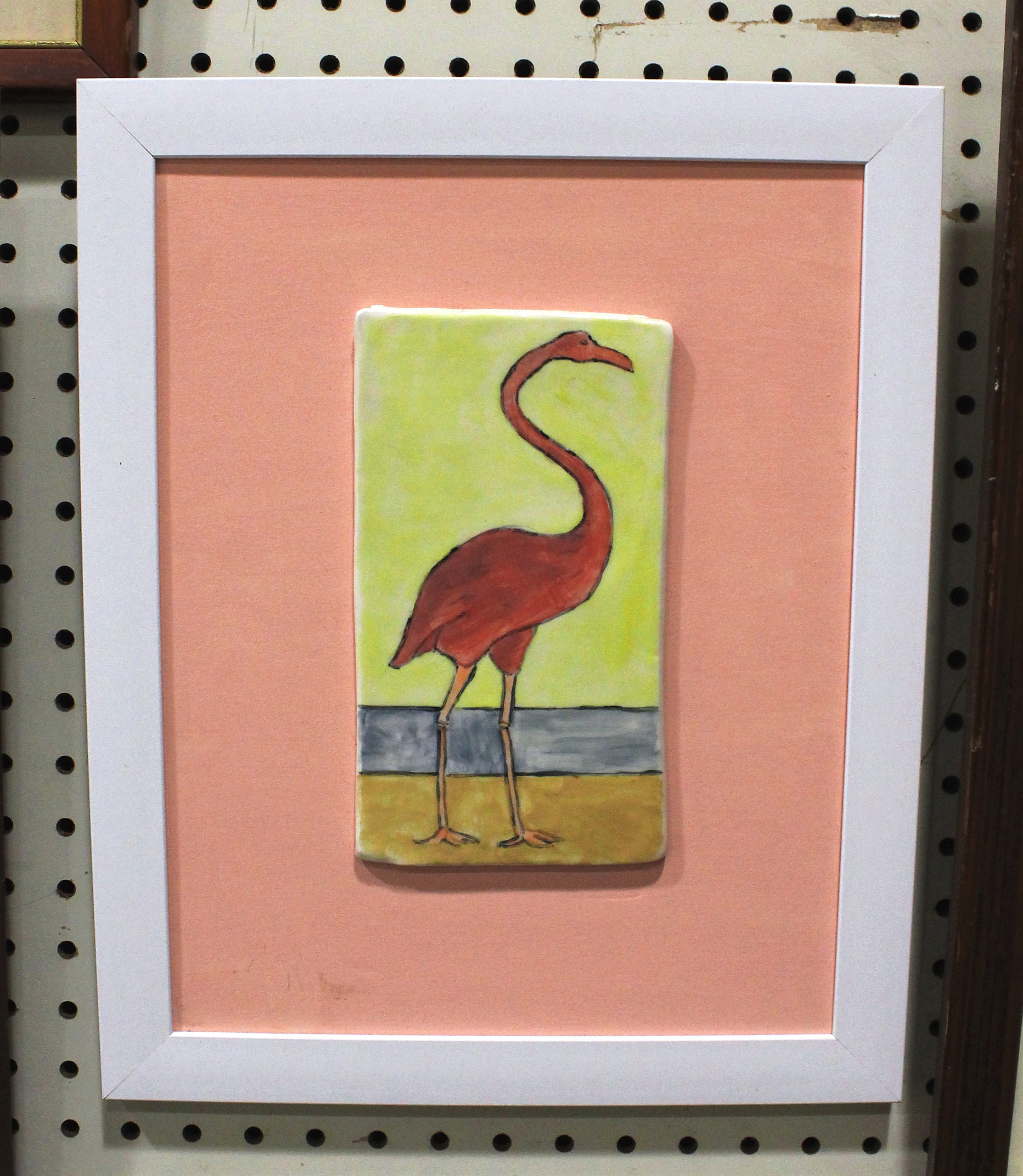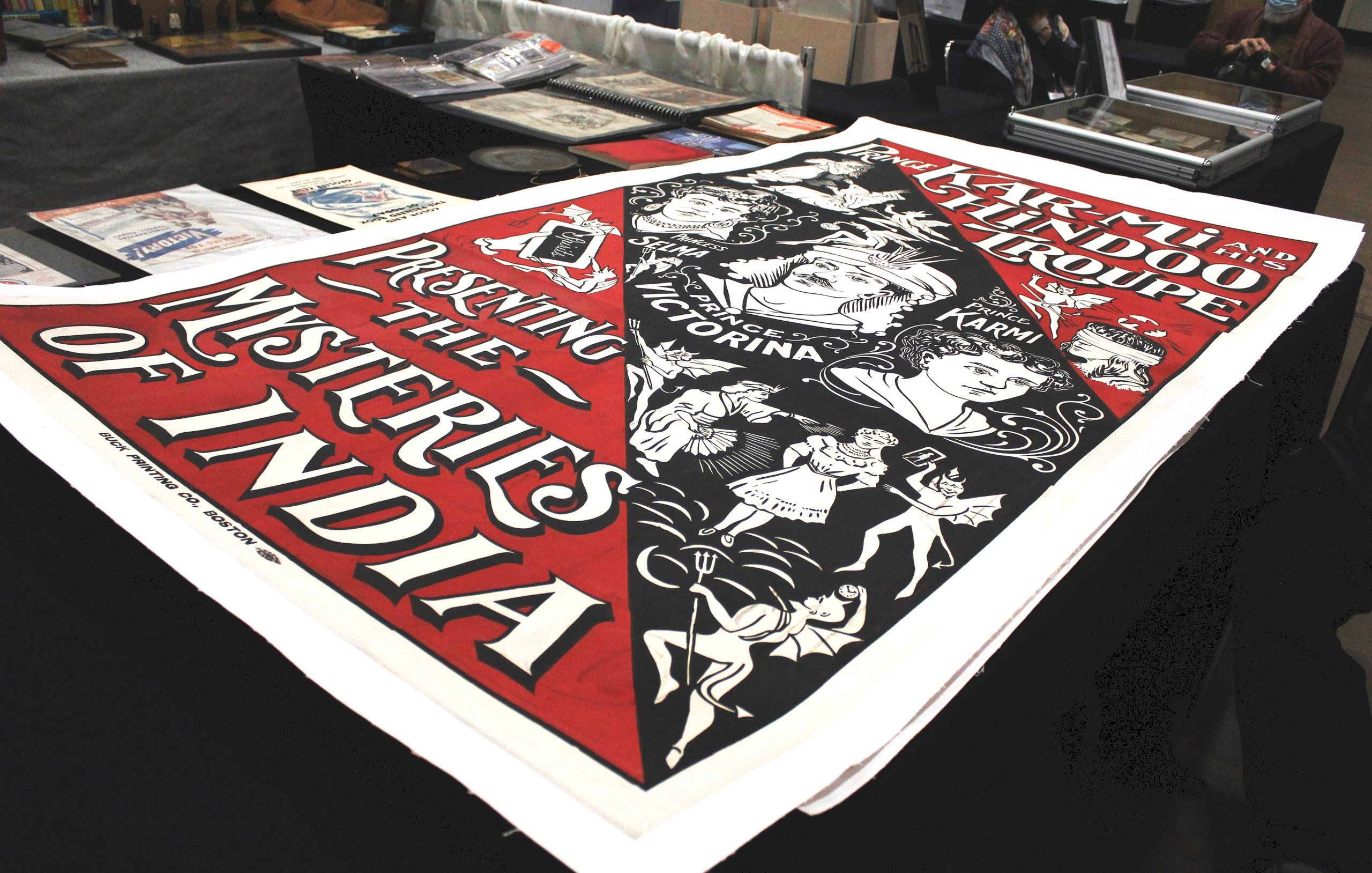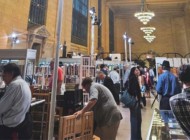
Buyers pour in at 10 am with their shopping bags empty; many left promptly to deposit their purchases and came back for more.
Review & Photos by Z.G. Burnett,
HARTFORD, CONN. — The area around the XL Center in downtown Hartford, Conn., was next to silent on the morning of Saturday, January 14. The action was all inside the stadium where dealers were making their last-minute adjustments and additions to their booths for Papermania Plus, which was celebrating its 83rd show. “We call the show ‘Papermania Plus’ because it’s so much more than that,” said showrunner Gary Gipstein. “Of course, we have paper and ephemera, but we invite all kinds of dealers to participate… and buy!” He added with a laugh.
Gipstein and his mother, Arlene Shea, have been conducting the show since the mid-1970s. Shea was busy arranging her booth in the main lobby before the opening, where a poster of the 1978 The Hartford Antiques Show was proudly displayed. Indeed, on this table and others throughout the show, antiques, collectibles and other memorabilia were presented. Many of the dealers in more than 75 booths have been showing with Gipstein and Shea for decades, and each of them brought objects that helped to contextualize the paper goods that formed the bulk of their stock.
Mickey Novak from Massachusetts was one such dealer, who was both excited about the show and wistful about its reduced size. Pulling the drape back from the empty half of the stadium floor, he described how in past years, the entire floor would have been packed with booths. With the recurrence of Covid making dealers and buyers mask up once again, there are many factors to this reduction, including some dealers just not being available for the date. “The Internet changed everything,” Novak mentioned, as well. “But you still never know what you’re going to find at these shows.” With few of the dealers having a website, or any kind of online presence, the best way to source great finds continues to be showing and shopping at shows like Papermania Plus. “It’s a ‘people’ business,” Novak emphasized.
This kind of human interaction was represented by one of Novak’s items, a 1906 autograph board that was ready for Valentine’s Day from Campbell, Metzger & Jacobson. The New York City company created many designs of lithographically printed canvases that were often given as gifts after being signed by multiple people, and many were used for pillowcases instead of being framed as mementos. Examples exist for brides and sports teams, full of well wishes for the recipient. Novak’s Valentine was in excellent condition, and he was asking $395.
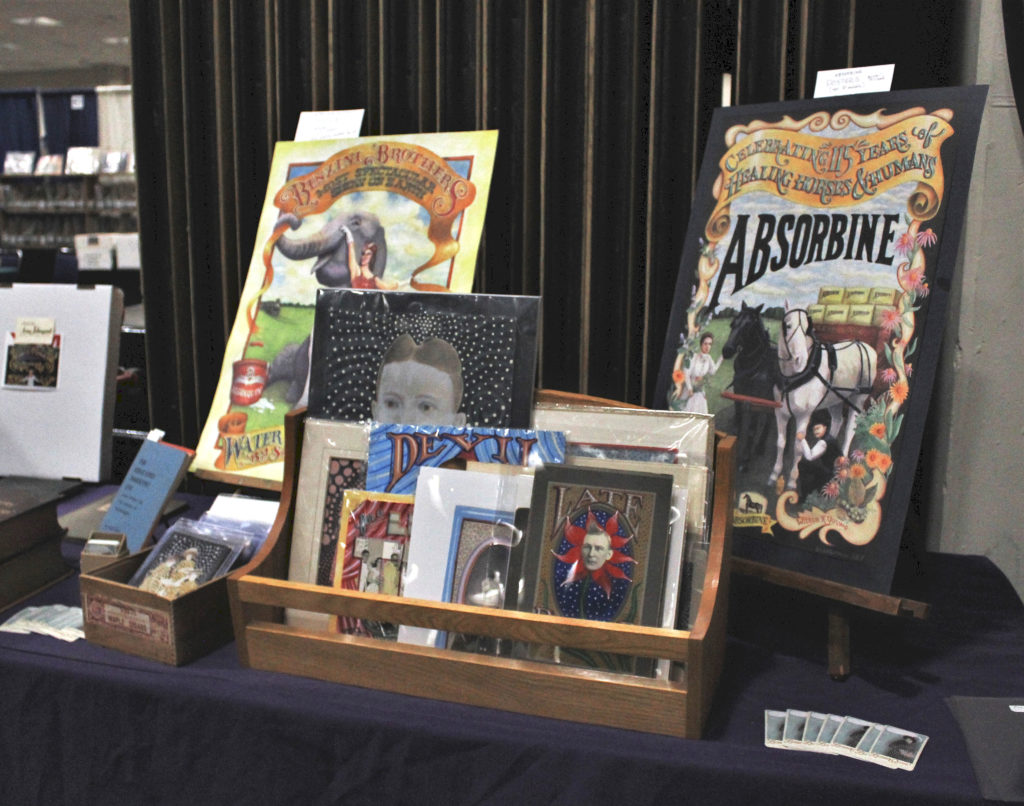
Amy Johnquest of BannerQueen Art & Design, Easthampton, Mass., brought a number of her “altered” works; posters, cabinet cards, cartes de visite and other media that Johnquest decorates by hand.
Barbara Loe of Cardtique, Osprey, Fla., was also in the seasonal spirit. By late morning, Loe and her booth were so busy that it was difficult to take a clear picture of the boxes of Victorian Valentine’s Day cards that were individually wrapped and displayed on her tables. Each of these cards was a delicate, well-preserved example of Nineteenth Century craftwork. Many had layers of details, including paper lace, embossed and hand-painted decoration, and a few even showed movable parts. Like so many paper goods from the golden age of print, it is remarkable that these Valentines have survived not only in such excellent condition, but with most of their pieces intact.
Richard Thorner of Resser-Thorner, Manchester, N.H., brought a sign from the same era, advertising the services of “Libbey & Co., Book, Card & Job Printers, And Publishers of The Dover Enquirer, Dover, N.H.” The Dover Enquirer was published from 1828 to 1900, but it is unclear whether or not this was also the end date of Libbey & Co. The company’s name appears as publishers in archival scans through the 1870s, but the company’s location in Dover is unknown. Nonetheless, its signage was effective in showing the press’s expertise. The royal blue cardstock sign was boldly printed with metallic ink that had lost none of its brilliance in the past 100-odd years and was an example of typeface diversity that hand-printing companies are just now starting to rediscover. Thorner was asking $650 for the advertisement.
Nineteenth Century ephemera was abundant at the show and dealers were enthusiastic about encouraging buyers and collectors of all levels to explore. Siblings Casey and Erin Waters of Lancaster, Penn., presented boxes of daguerreotypes and ambrotypes in bundle deals, dependent upon their quality. Finer examples in excellent condition were individually priced in a case alongside, marked $250 and up. Erin kindly lifted up the glass for us to take a picture. “The light’s actually working for us,” she said. “[The daguerreotypes] really seem to glow.” Hard as it is to capture even in a high-resolution photograph, the details of these were almost as crisp as they were on the day they were taken.
Artist Amy Johnquest was also selling early photography, but in a quite different way. Each photograph was decorated with her own illustration, either through paint or collaged mixed media. Johnquest began her career as a sign painter and graphic designer, and later created a sideshow-themed art piece that started her business, BannerQueen. Many of the pieces available were part of her “altered” works, such as cabinet cards, cartes de visite and mixed media decorated with hand-painted dots, letters and images.
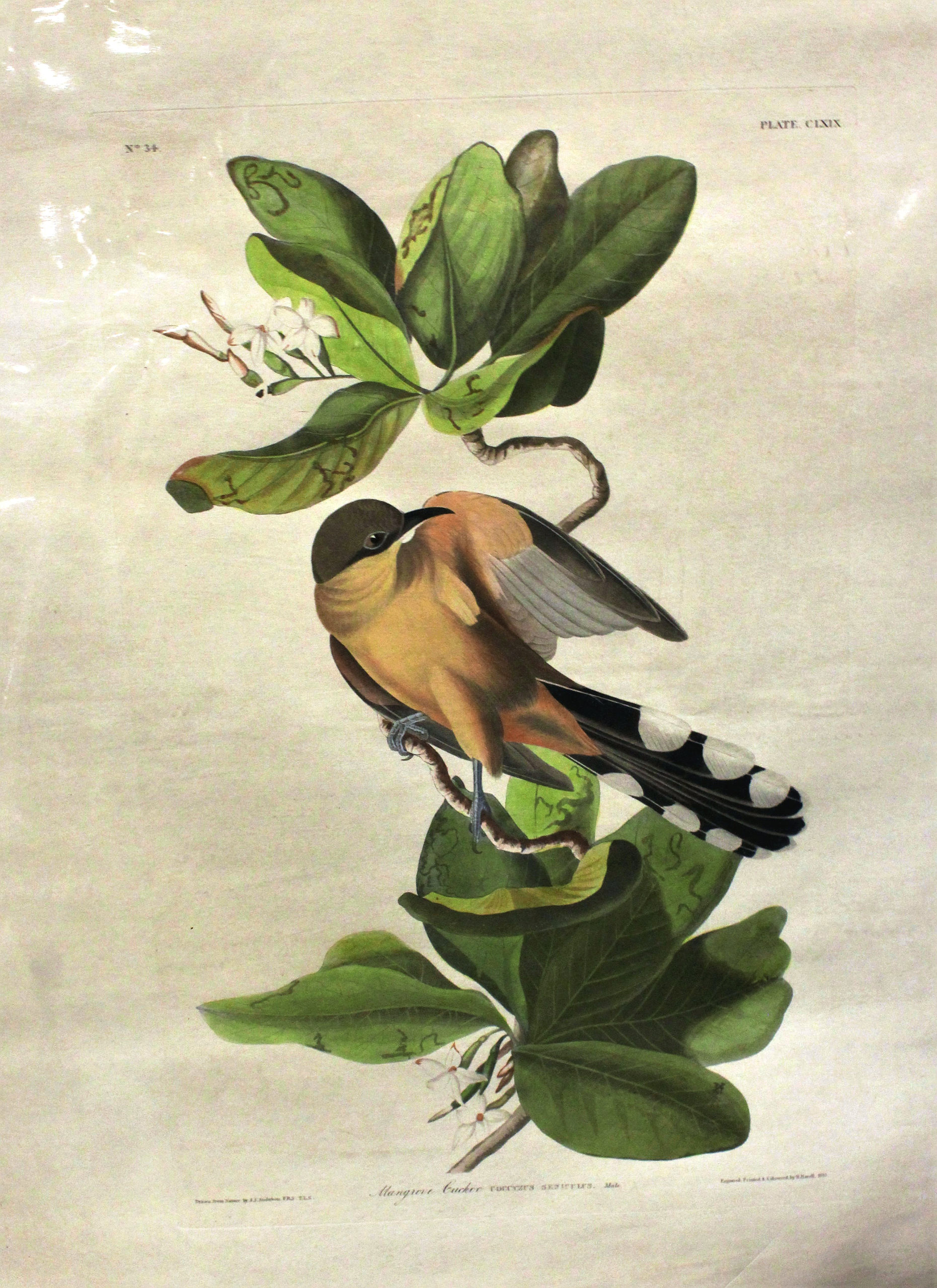
Detail of original, hand-painted elephant folio leaf from Audubon’s Birds of America, from William Hutchinson, Penn., for $1,500.
Images from the darker reaches of photography were also available, using only three to four words to express the thousand that a picture is worth. Ron Haerberle was a combat photographer during the Vietnam War, using black and white film to document the activity of Charlie Company, 1st Battalion, 20th Infantry Regiment in 1968. Those photos were taken with his military-issue camera, and turned in during the end of his service. However, Haeberle recorded his own images with color film that he retained and sold upon arriving in the United States. These images showed the true brutality of the conflict, including documentation of the massacre by American soldiers at the village of My Lai that occurred on March 16 that year. The photograph used on a poster in the booth of the John Bale Book Company of Waterbury, Conn., first appeared in full cover for a 1969 Life magazine story, and became one of the most effective anti-war images of the era. The Workers’ Coalition used excerpts from Haeberle’s interview superimposed on the poster’s first printing, “Q: And babies? A: And babies.” The 1969 poster was later changed to display “Four more years?” in protest to President Richard Nixon’s upcoming reelection. The poster was priced $250.
Another large-format and extremely rare piece was found in the booth of Elliot Sherman, whose broad range of offerings made room for a poster advertising Kar-mi and his Hindoo Troupe, Presenting the Mysteries of India. Known legally as Joseph Hollingsworth, “Kar-mi” was the last persona he created during a career in stage magic, during which he dressed as an Indian prince to perform illusions. Hollingsworth was also a tattoo artist who would set up shop in between performances; it is unknown as to whether or not he shed what is now seen as an extremely controversial costume. Thrifty as well as opportunistic, Hollingsworth would use the same posters for his act through the years, covering his former stage name “Victorina” with “Kar-mi” later in his career. This was not the case with Sherman’s poster, few of which survive due to the poor quality of the paper on which it was printed; it had been restored and relined, and Sherman was asking $1,800.
If dealers were somewhat subdued by the relatively shorter length of their booth list before opening, their anxiety was assuaged by the number of buyers that populated the show in just two hours. By noon, Shea estimated that most of the people coming in and out of the show with shopping bags in tow were known dealers and collectors, but many were also new faces and younger participants. “It was an excellent show,” Gipstein shared a few days later. “The majority of vendors were happy, and we had a great turnout despite being only a one-day event.” It was the quality of the dealers that drew customers who were not at all deterred by the show’s smaller size, which is a point of pride in the operation. Gipstein also believes that although their numbers were reduced, the resurgence of interest in antiques shows writ large is on the upswing, which was supported by the crowds in attendance. “We originally only had 40 or 50 dealers when we first started out,” he said. “In 1988, we worked up to 125, and then to around 150 in the ‘90s. We definitely had a drop with Covid, but so did everybody.” As interest in ephemera and antiques grows among a younger demographic of collectors and dealers, shows like Papermania Plus will certainly continue to deliver deals and great finds for growing collections. “I foresee the next show being even bigger,” Gipstein concluded. We look forward to seeing it!
The XL Center is at 1 Civic Plaza Center. The 84th Papermania Plus Antique Paper Show will be on August 26. For information, 860-280-8339 or www.papermaniaplus.com.













